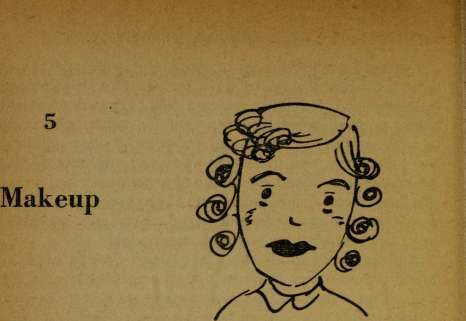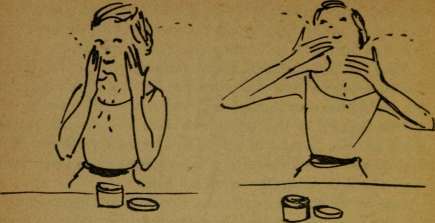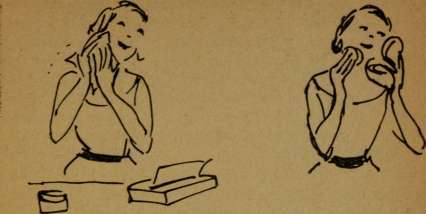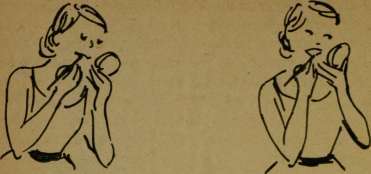The most successful time to experiment with your hair is when it is being shampooed. Hair that is stiff with lather can be twisted and turned like molasses taffy. The next time your hair is washed, before you rinse out the lather, spend five minutes in front of your mirror, arranging it in new positions. You might very well discover a much more exciting way to wear your hair. Never be afraid to experiment. If you cut your hair, it can always grow back. If you curl it, you can always uncurl it again. As long as you have hair, you need never feel that anything you do is irredeemable.
Most important of all, don't let yourself become a fuddy-duddy about fashion. Don't stick to a pompadour when it has gone out of style. Don't keep on wearing your hair the same old way, when the passe styles make you look old hat. Don't throw caution to the winds, of course, but do discover that you can stick to the basic hairstyle guideposts and still change your hair when you want to. Remember that a pompadour adds height, but so does a flipped-up bang. In hair, as in anything else, there is always more than one way to skin a cat.
The real secret of lovely hair is sleekness. Hair that is soft, gleaming, shaped, and shining will never go out of date. Fancy bits of business like spit curls and one-inch bobs may come and go, but well-groomed hair will stay forever. If you keep your hair healthy, if you change the style often enough, you can count on it that you will be known as a girl with beautiful hair.

"Nothing I do ever seems to make me look any better."
There is nothing so discouraging as spending a lot of time fussing around with your face and then feeling when you have finished that nothing has been accomplished. I know how grim that feeling can be. It took me some time before I got the knack of making myself up well. In the process of trial and error I discovered this fact: a good deal of the success in makeup comes from first knowing what and then knowing how to make up.
What to make up is the first problem. Some of us make up too much of our faces. Others don't make up enough. Finding the happy medium is the problem. Even when that happy medium has been established, we still have the problem of how, and that's where most of us fall down. For my part, I think that the answer to the question of how-to lies in the phrase "keep a straight face." That is, put your makeup on neatly and evenly. Don't be satisfied until you have a perfect job. A pretty mouth turned topsy-turvy by a hasty application of lipstick is no credit to anybody's face.
Many of the problems about makeup stem from the fact that nobody ever told you how to go about it. From that blissful day when your mother told you it was all right to wear a little lipstick to that big party until now, you have been going along in a kind of hit-or-miss fashion. Well, this is the time to get down to the basic fundamentals and learn what's what about makeup. It won't take long.
One of the first things to learn is that you must never let your makeup look obvious. First and foremost, makeup should look natural, not artificial. That means that you have to be artful about your artifice—and that's where the little tricks come in. Some of these tricks will seem time-consuming and some too picayune to bother about, but they are all important to the final, happy result. Just wait and see.
One of the most important points is the color powder you choose. Powder should match the color of your skin; it should be neither darker nor lighter. One of the best investments you can make is to have your powder individually blended to your skin tone. Thus, as your skin color changes, as it becomes tanned in summer or paler in winter, the color of your powder can change with it.
If you do not have your powder blended, then be careful to choose carefully from the numerous kinds available. Get as close a match to your skin as possible. Do not make the mistake of thinking that a pale pinky powder over an olive skin will make you seem all peaches and cream or that a dark powder over a fair skin will make you look tanned. You won't get the effect. What you will get is the rather untidy result of wearing a sheer white organdy dress over a black slip or vice versa. Don't forget that your skin color is your own-part of nature's individual plan for you—so take it the way you find it and make the most of it.

The powder of your selection should be applied with a clean puff—a new one every day. To make sure that you have a constant supply on hand, buy those inexpensive little packages that contain a dozen or so of the small puffs designed specifically to be discarded after one use. In a pinch, clean cotton will do the trick, but if you use it be careful to remove any fuzz it may leave on the skin.
Puff your powder on oh so sparingly, and then brush off the excess. Never have your powder look as though you dunked your head in the box. If possible, work under a strong light so that you can see what you are doing. That way you will make certain to powder well up into the hairline and down into the area of the neck and ears. Don't leave any high-water marks.
The purpose of powder is to give the skin a smooth, even surface, to dull shine and to disguise rough bumps. Powder well applied will make your complexion seem luminous. Essentially, powder does not put color in your cheeks. That is the function of rouge. However, few teen-agers need to add color, for their skins have a glowing light of their own derived from an active outdoor life.

I personally don't advise rouge for teens, but if there are some who feel that they are utterly washed out without it, then a very little bit high on the cheekbone and with the outlines blended well is permissible. But for Heaven's sake use only a little. Rouge goes a long way. Proms and parties, where you will be looked at under artificial light, are the best occasions to try out rouge (if you must), for the strong unnatural lighting will soften the coloring.
Select a shade of lipstick which blends well with your natural coloring. Steer away from theatrical oranges and purples. The more natural-looking pink and red tones are best for you. Look like yourself!
When it comes to applying lipstick, use a brush. A brush will more accurately define the lip edges, and once you get the hang of it, it is easier to wield than the blunt end of a lipstick. Use the brush to draw the outlines of your mouth and the blunt stick to fill in the rest.
Now, you ask, what outline should I draw? Generally speaking, one should follow the natural curves of the mouth, but some improvements can be made on nature. Most mouths can be divided into the four following classifications:
1. The wide, full.
2. The small bow.

3. The long, thin.
4. The full under or upper lip.
Starting with any one of these outlines, a girl can make her mouth over to a more becoming shape. The girl with a wide, full mouth should use her brush to draw an outline somewhat smaller than the natural outline. The girl with a small bow (since the small bow went out of fashion with Clara Bow, who was a famous beauty before your time) should enlarge the natural outline, particularly as she goes toward the tapering points. The girl with the long, thin mouth should increase the width of her mouth at the center, and the girl with a full under (or upper) lip should decrease the size of the larger lip and increase the smaller one to bring both into balance. All this, my friends, is possible with a lip brush.
One further point about applying lipstick that many teens (and many adults) don't realize is that lipstick should not be used in the very corners of the mouth. If so used, it will smear. Instead draw your outline not quite to the corner and then stop. Another trick to prevent smearing or caking is to dust your lips with powder before putting on lipstick and then, after applying it, blot your mouth well with tissue.